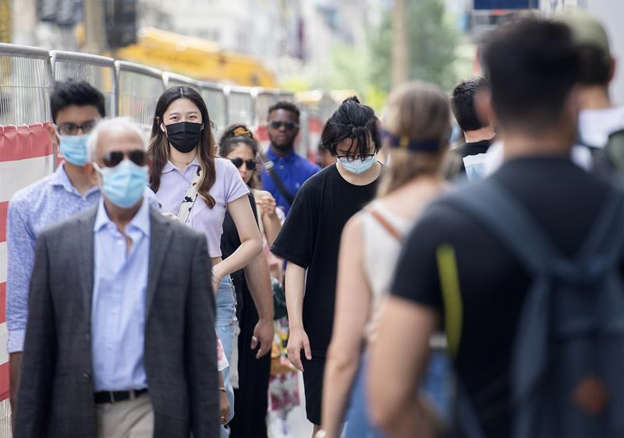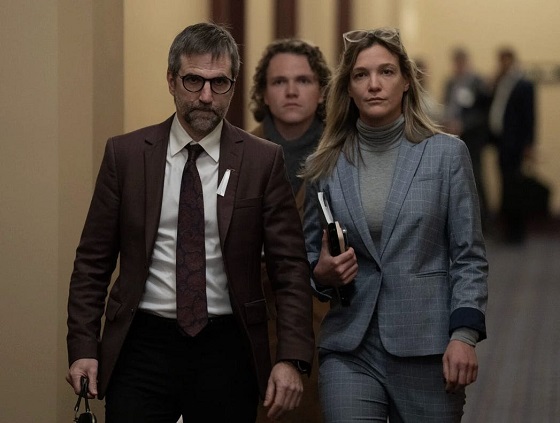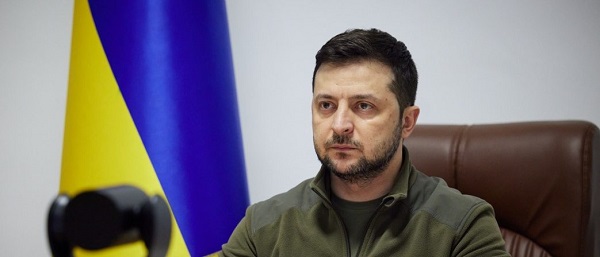Brownstone Institute
A Closer Look at the Covid Mortality Rate

Article from the Brownstone Institute
BY
One of the most consistent efforts made by “experts” during the early stages of the pandemic was to attempt to impress on the public that COVID was an extremely deadly disease.
While it’s clear that for the extremely elderly and severely immunocompromised, COVID does present significant and serious health concerns, the “experts” did their best to convince people of all age groups that they were in danger.
Initially the World Health Organization, in their infinite incompetence, made a substantial contribution to this perception by claiming that the mortality rate from COVID was shockingly high.
In March 2020, with precious little data, the WHO made the alarming claim that 3.4% of people who got COVID had died.
CNBC reported that an early press conference by WHO Director-General Tedros Ghebreyesus compared that expected mortality of COVID-19 to the flu:
“Globally, about 3.4% of reported COVID-19 cases have died,” WHO Director-General Tedros Adhanom Ghebreyesus said during a press briefing at the agency’s headquarters in Geneva. In comparison, seasonal flu generally kills far fewer than 1% of those infected, he said.
This stood in contrast to previous estimates, which were also above 2%:
“Early in the outbreak, scientists had concluded the death rate was around 2.3%.”
While “experts” could be forgiven for being unsure about the death rate of a brand new illness with very little data available, the fear-mongering and world-altering policy enacted based on these estimates has caused incalculable damage.
It’s now widely known and accepted that these estimates were wildly incorrect, off by orders of magnitude.
But a new paper out from one of the world’s leading experts confirms that they were off even more than we previously realized.
John Ioannidis is one of the nation’s leading public health experts, employed at Stanford University as Professor of Medicine in Stanford Prevention Research, of Epidemiology and Population Health,” as well as “of Statistics and Biomedical Data Science.”
You’d think that those impeccable qualifications and a track record of being one of the most published and cited scientists in the modern world would insulate him from criticism, but unfortunately that’s no longer how The Science™ works.
Ioannidis first drew the ire of The Keepers of The Science™ early in the outbreak, when he cautioned that society might be making tremendous decisions based on limited data that was of poor quality.
He also took part in the infamous seroprevalence study conducted in Santa Clara County, led by Dr. Jay Bhattacharya.
That examination, which looked at antibody prevalence in the San Jose area, came to the conclusion that COVID was already significantly more widespread by March and April 2020 than most people realized.
This had wide-ranging implications, but the most important revelation was that the estimates of COVID’s mortality rate used by “scientists” and the WHO were almost certainly much too high.
Those estimates were created under the assumption that COVID cases were overwhelmingly detectable; that cases were captured by testing and thus tracking deaths could be achieved with a “case fatality rate,” instead of “infection fatality rate.”
That was the mistake Tedros and the WHO made two and a half years ago.
Of course, for providing substantial evidence and data that COVID was less deadly than initially feared, Ioannidis (and Bhattacharya) was attacked from within the “expert community.”
In what has now become a familiar insult, those behind the study were vilified as COVID minimizers and dangerous conspiracy theorists who would get people killed by not taking the virus seriously enough.
But Ioannidis remained undeterred, and with several authors, he recently released another review of the infection fatality rate of COVID. Importantly, the paper looks at the pre-vaccination time period and covers the non-elderly age groups; those who were most affected by COVID restrictions and endless mandates.
The Numbers
The review begins with a statement of fact that was almost entirely ignored by lockdown “experts” throughout the pandemic, but especially when restrictions, lockdowns and mandates were at their peak early on.
The infection fatality rate (IFR) of COVID-19 among non-elderly people in the absence of vaccination or prior infection is important to estimate accurately, since 94% of the global population is younger than 70 years and 86% is younger than 60 years.
Emphasis added.
94% of the global population is younger than 70 years old.
6% of is older than 70 years old.
86% is younger than 60 years old.
This is relevant because restrictions overwhelmingly impacted the 86-94% of people who are younger than 60 or 70 years old.
Ioannidis and his co-writers reviewed 40 national seroprevalence studies that covered 38 countries to come to determine their estimates of infection fatality rate for the overwhelming majority of people.
Importantly, those seroprevalence studies were conducted before the vaccines were released, meaning the IFR’s were calculated before whatever impact vaccines had on younger age groups.
So what did they find?
The median infection fatality rate for those aged 0-59 was 0.035%.
This represents 86% of the global population and the survival rate for those who were infected with COVID pre-vaccination was 99.965%.
For those aged 0-69, which covers 94% of the global population, the fatality rate was 0.095%, meaning the survival rate for nearly 7.3 billion people was 99.905%.
Those survival rates are obviously staggeringly high, which already creates frustration that restrictions were imposed on all age groups, when focused protection for those over 70 or at significantly elevated risk would have been a much more preferable course of action.
But it gets worse.
The researchers broke down the demographics into smaller buckets, showing the increase in risk amongst older populations, and conversely, how infinitesimal the risk was amongst younger age groups.
- Ages 60-69, fatality rate 0.501%, survival rate 99.499%
- Ages 50-59, fatality rate 0.129%, survival rate 99.871%
- Ages 40-49, fatality rate 0.035% survival rate 99.965%
- Ages 30-39, fatality rate 0.011%, survival rate 99.989%
- Ages 20-29, fatality rate 0.003%, survival rate 99.997%
- Ages 0-19, fatality rate 0.0003%, survival rate 99.9997%
They added that “Including data from another 9 countries with imputed age distribution of COVID-19 deaths yielded median IFR of 0.025-0.032% for 0-59 years and 0.063-0.082% for 0-69 years.”
These numbers are astounding and reassuringly low, across the board.
But they’re almost nonexistent for children.
Yet as late as fall 2021, Fauci was still fear-mongering about the risks of COVID to children in order to increase vaccination uptake, saying in an interview that it was not a “benign situation:”
“We certainly want to get as many children vaccinated within this age group as we possibly can because as you heard and reported, that this is not, you know, a benign situation.”
It’s nearly impossible for any illness to be less of a risk, or more “benign” than a 0.0003% risk of death.
Even in October 2021, during that same interview with NPR, Fauci said that masks should continue on children as an “extra step” to protect them, even after vaccination:
And when you have that type of viral dynamic, even when you have kids vaccinated, you certainly – when you are in an indoor setting, you want to make sure you go the extra step to protect them. So I can’t give you an exact number of what that would be in the dynamics of virus in the community, but hopefully we will get there within a reasonable period of time. You know, masks often now – as we say, they’re not forever. And hopefully we’ll get to a point where we can remove the masks in schools and in other places. But I don’t believe that that time is right now.
Nothing better highlights the incompetence and misinformation from Dr. Fauci than ignoring that pre-vaccination, children were at vanishingly small risks from COVID, that vaccination uptake amongst kids was entirely irrelevant since they do not prevent infection or transmission, and that mask usage is completely ineffective at protecting anyone. Especially for those who didn’t need protection in the first place.
The CDC, “expert” community, World Health Organization, media figures — all endlessly spread terror that the virus was a mass killer while conflating detected case fatality rates with infection fatality rates.
Yet now we have another piece of evidence suggesting that the initial WHO estimates were off by 99% for 94% of the world’s population.
Just for some perspective, here’s the difference visually portrayed between what the WHO claimed and what Ioannidis found:

Even if the lockdowns, mask mandates, capacity limits and shuttered playgrounds worked, the dangers of the virus were so minuscule that the collateral damage instantly and immediately outweighed any potential benefit.
Economic destruction, increased suicide attempts due to seemingly indefinite isolation, horrifying levels of learning loss, increasing obesity amongst kids, plummeting test scores, increased poverty and hunger, supply chain problems, rampant inflation; all of it is a direct result of policies imposed by terrified, incompetent “experts.”
Their estimates were hopelessly, catastrophically wrong, yet they maintained their unchallenged sense of authority for multiple years, and still receive awards, praise, increased funding and a sense of infallibility amongst politicians and decision-makers.
If sanity and intellectual honesty still existed, these estimates would be front page news for every major media outlet in the world.
Instead, because the media and their allies in the tech, corporate, and political classes promoted and encouraged lockdowns and restrictions while censoring dissent, it’s ignored.
Nothing could be more perfectly COVID than that.
Republished from the author’s Substack
Brownstone Institute
Bizarre Decisions about Nicotine Pouches Lead to the Wrong Products on Shelves

From the Brownstone Institute
A walk through a dozen convenience stores in Montgomery County, Pennsylvania, says a lot about how US nicotine policy actually works. Only about one in eight nicotine-pouch products for sale is legal. The rest are unauthorized—but they’re not all the same. Some are brightly branded, with uncertain ingredients, not approved by any Western regulator, and clearly aimed at impulse buyers. Others—like Sweden’s NOAT—are the opposite: muted, well-made, adult-oriented, and already approved for sale in Europe.
Yet in the United States, NOAT has been told to stop selling. In September 2025, the Food and Drug Administration (FDA) issued the company a warning letter for offering nicotine pouches without marketing authorization. That might make sense if the products were dangerous, but they appear to be among the safest on the market: mild flavors, low nicotine levels, and recyclable paper packaging. In Europe, regulators consider them acceptable. In America, they’re banned. The decision looks, at best, strange—and possibly arbitrary.
What the Market Shows
My October 2025 audit was straightforward. I visited twelve stores and recorded every distinct pouch product visible for sale at the counter. If the item matched one of the twenty ZYN products that the FDA authorized in January, it was counted as legal. Everything else was counted as illegal.
Two of the stores told me they had recently received FDA letters and had already removed most illegal stock. The other ten stores were still dominated by unauthorized products—more than 93 percent of what was on display. Across all twelve locations, about 12 percent of products were legal ZYN, and about 88 percent were not.
The illegal share wasn’t uniform. Many of the unauthorized products were clearly high-nicotine imports with flashy names like Loop, Velo, and Zimo. These products may be fine, but some are probably high in contaminants, and a few often with very high nicotine levels. Others were subdued, plainly meant for adult users. NOAT was a good example of that second group: simple packaging, oat-based filler, restrained flavoring, and branding that makes no effort to look “cool.” It’s the kind of product any regulator serious about harm reduction would welcome.
Enforcement Works
To the FDA’s credit, enforcement does make a difference. The two stores that received official letters quickly pulled their illegal stock. That mirrors the agency’s broader efforts this year: new import alerts to detain unauthorized tobacco products at the border (see also Import Alert 98-06), and hundreds of warning letters to retailers, importers, and distributors.
But effective enforcement can’t solve a supply problem. The list of legal nicotine-pouch products is still extremely short—only a narrow range of ZYN items. Adults who want more variety, or stores that want to meet that demand, inevitably turn to gray-market suppliers. The more limited the legal catalog, the more the illegal market thrives.
Why the NOAT Decision Appears Bizarre
The FDA’s own actions make the situation hard to explain. In January 2025, it authorized twenty ZYN products after finding that they contained far fewer harmful chemicals than cigarettes and could help adult smokers switch. That was progress. But nine months later, the FDA has approved nothing else—while sending a warning letter to NOAT, arguably the least youth-oriented pouch line in the world.
The outcome is bad for legal sellers and public health. ZYN is legal; a handful of clearly risky, high-nicotine imports continue to circulate; and a mild, adult-market brand that meets European safety and labeling rules is banned. Officially, NOAT’s problem is procedural—it lacks a marketing order. But in practical terms, the FDA is punishing the very design choices it claims to value: simplicity, low appeal to minors, and clean ingredients.
This approach also ignores the differences in actual risk. Studies consistently show that nicotine pouches have far fewer toxins than cigarettes and far less variability than many vapes. The biggest pouch concerns are uneven nicotine levels and occasional traces of tobacco-specific nitrosamines, depending on manufacturing quality. The serious contamination issues—heavy metals and inconsistent dosage—belong mostly to disposable vapes, particularly the flood of unregulated imports from China. Treating all “unauthorized” products as equally bad blurs those distinctions and undermines proportional enforcement.
A Better Balance: Enforce Upstream, Widen the Legal Path
My small Montgomery County survey suggests a simple formula for improvement.
First, keep enforcement targeted and focused on suppliers, not just clerks. Warning letters clearly change behavior at the store level, but the biggest impact will come from auditing distributors and importers, and stopping bad shipments before they reach retail shelves.
Second, make compliance easy. A single-page list of authorized nicotine-pouch products—currently the twenty approved ZYN items—should be posted in every store and attached to distributor invoices. Point-of-sale systems can block barcodes for anything not on the list, and retailers could affirm, once a year, that they stock only approved items.
Third, widen the legal lane. The FDA launched a pilot program in September 2025 to speed review of new pouch applications. That program should spell out exactly what evidence is needed—chemical data, toxicology, nicotine release rates, and behavioral studies—and make timely decisions. If products like NOAT meet those standards, they should be authorized quickly. Legal competition among adult-oriented brands will crowd out the sketchy imports far faster than enforcement alone.
The Bottom Line
Enforcement matters, and the data show it works—where it happens. But the legal market is too narrow to protect consumers or encourage innovation. The current regime leaves a few ZYN products as lonely legal islands in a sea of gray-market pouches that range from sensible to reckless.
The FDA’s treatment of NOAT stands out as a case study in inconsistency: a quiet, adult-focused brand approved in Europe yet effectively banned in the US, while flashier and riskier options continue to slip through. That’s not a public-health victory; it’s a missed opportunity.
If the goal is to help adult smokers move to lower-risk products while keeping youth use low, the path forward is clear: enforce smartly, make compliance easy, and give good products a fair shot. Right now, we’re doing the first part well—but failing at the second and third. It’s time to fix that.
Addictions
The War on Commonsense Nicotine Regulation

From the Brownstone Institute
Cigarettes kill nearly half a million Americans each year. Everyone knows it, including the Food and Drug Administration. Yet while the most lethal nicotine product remains on sale in every gas station, the FDA continues to block or delay far safer alternatives.
Nicotine pouches—small, smokeless packets tucked under the lip—deliver nicotine without burning tobacco. They eliminate the tar, carbon monoxide, and carcinogens that make cigarettes so deadly. The logic of harm reduction couldn’t be clearer: if smokers can get nicotine without smoke, millions of lives could be saved.
Sweden has already proven the point. Through widespread use of snus and nicotine pouches, the country has cut daily smoking to about 5 percent, the lowest rate in Europe. Lung-cancer deaths are less than half the continental average. This “Swedish Experience” shows that when adults are given safer options, they switch voluntarily—no prohibition required.
In the United States, however, the FDA’s tobacco division has turned this logic on its head. Since Congress gave it sweeping authority in 2009, the agency has demanded that every new product undergo a Premarket Tobacco Product Application, or PMTA, proving it is “appropriate for the protection of public health.” That sounds reasonable until you see how the process works.
Manufacturers must spend millions on speculative modeling about how their products might affect every segment of society—smokers, nonsmokers, youth, and future generations—before they can even reach the market. Unsurprisingly, almost all PMTAs have been denied or shelved. Reduced-risk products sit in limbo while Marlboros and Newports remain untouched.
Only this January did the agency relent slightly, authorizing 20 ZYN nicotine-pouch products made by Swedish Match, now owned by Philip Morris. The FDA admitted the obvious: “The data show that these specific products are appropriate for the protection of public health.” The toxic-chemical levels were far lower than in cigarettes, and adult smokers were more likely to switch than teens were to start.
The decision should have been a turning point. Instead, it exposed the double standard. Other pouch makers—especially smaller firms from Sweden and the US, such as NOAT—remain locked out of the legal market even when their products meet the same technical standards.
The FDA’s inaction has created a black market dominated by unregulated imports, many from China. According to my own research, roughly 85 percent of pouches now sold in convenience stores are technically illegal.
The agency claims that this heavy-handed approach protects kids. But youth pouch use in the US remains very low—about 1.5 percent of high-school students according to the latest National Youth Tobacco Survey—while nearly 30 million American adults still smoke. Denying safer products to millions of addicted adults because a tiny fraction of teens might experiment is the opposite of public-health logic.
There’s a better path. The FDA should base its decisions on science, not fear. If a product dramatically reduces exposure to harmful chemicals, meets strict packaging and marketing standards, and enforces Tobacco 21 age verification, it should be allowed on the market. Population-level effects can be monitored afterward through real-world data on switching and youth use. That’s how drug and vaccine regulation already works.
Sweden’s evidence shows the results of a pragmatic approach: a near-smoke-free society achieved through consumer choice, not coercion. The FDA’s own approval of ZYN proves that such products can meet its legal standard for protecting public health. The next step is consistency—apply the same rules to everyone.
Combustion, not nicotine, is the killer. Until the FDA acts on that simple truth, it will keep protecting the cigarette industry it was supposed to regulate.
-

 Alberta2 days ago
Alberta2 days agoFrom Underdog to Top Broodmare
-

 Business2 days ago
Business2 days agoMan overboard as HMCS Carney lists to the right
-

 Business2 days ago
Business2 days agoHigher carbon taxes in pipeline MOU are a bad deal for taxpayers
-

 Alberta2 days ago
Alberta2 days agoREAD IT HERE – Canada-Alberta Memorandum of Understanding – From the Prime Minister’s Office
-

 Daily Caller2 days ago
Daily Caller2 days agoZelenskyy Under Siege As Top Aide Resigns After Home Raided In Major Corruption Scandal
-

 Alberta1 day ago
Alberta1 day agoIEA peak-oil reversal gives Alberta long-term leverage
-

 Bruce Dowbiggin1 day ago
Bruce Dowbiggin1 day agoHealthcare And Pipelines Are The Front Lines of Canada’s Struggle To Stay United
-

 Alberta1 day ago
Alberta1 day agoAlberta can’t fix its deficits with oil money: Lennie Kaplan













